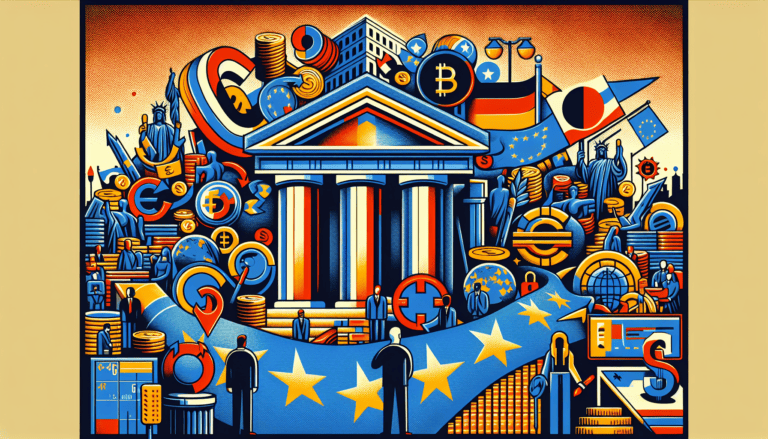Unmasking the Culprits: The Housing Market Bubble and Subprime Mortgage Crisis Unveiled

Unpacking Financial Market Crises
Financial market crises have been a recurring theme throughout history, each leaving its unique footprint on the economy. Understanding these events provides valuable insights into the vulnerabilities of financial systems and the importance of market stability.
Historical Overview of Crises
Financial crises are not a modern-day phenomenon. From the Tulip Mania of the 17th century to the more recent 2008 global financial crisis, markets have experienced dramatic ups and downs. One of the earliest notable crises is The Great Depression of the 1930s, which had profound economic implications worldwide.
In the late 20th century, the world witnessed the Asian financial crisis of 1997, followed by the Russian financial crisis of 1998. Each crisis had distinct causes, from excessive borrowing and lending to speculative investments that did not pay off. The dot-com bubble burst of 2000 and Black Monday of 1987 are further examples of how speculative excess can lead to significant market corrections.
A more recent and pertinent example is the housing market bubble and subprime mortgage crisis, which became emblematic of financial excess and regulatory failure. This crisis was marked by an unsustainable rise in housing prices, fueled by lower interest rates, easy credit access, and rampant speculation (Investopedia).
Key Elements of Market Stability
Market stability hinges on several key elements, which, when compromised, can lead to financial turmoil. These include:
- Robust Regulatory Frameworks: The absence of sufficient oversight can lead to risky behaviors that jeopardize market stability. The role of regulatory failures in financial crises is a critical lesson from past events.
- Transparency and Risk Assessment: Markets function healthily when participants have clear information about investment risks and rewards. The lack of transparency in bundling subprime mortgages into securities contributed to the housing market bubble and subprime mortgage crisis.
- Global Cooperation: Given the interconnectedness of modern finance, international cooperation is vital to manage financial contagion and cross-border effects.
- Sustainable Credit Practices: The impact of excessive leverage on financial stability cannot be overstated. Credit should be extended responsibly, with an eye toward the borrower’s ability to repay.
- Monetary Policy: Central banks play a crucial role in maintaining economic stability by setting interest rates and controlling money supply. The Federal Reserve’s low-interest-rate policy was a notable factor in the housing market bubble.
Studying these elements and past crises, like the Latin American debt crisis or the European debt crisis, helps investors grasp the complexities of financial markets. It also underscores the importance of crisis prevention and the lessons learned from past financial crises. As history has shown, market stability is multifaceted and requires vigilance from all market participants to maintain.
Anatomy of the Housing Bubble
The housing market bubble is a temporary condition characterized by the speculative buying of real estate, followed by a surge in housing prices which eventually leads to a market correction or a burst. Understanding the anatomy of the housing bubble is essential to grasp the underlying factors that led to the subprime mortgage crisis.
The Rise of Housing Prices
The period leading up to the housing market bubble saw a dramatic escalation in home values. From 1997 to 2006, housing prices surged by 124%, reaching a peak in 2006 (Investopedia). This increase was propelled by a combination of factors, including an uptick in demand, accessibility to homeownership through subprime mortgages, and a widespread anticipation that housing prices would consistently escalate.
The table below illustrates the sharp ascent in housing prices:
| Year | Percentage Increase in Housing Prices |
|---|---|
| 1997 | Base Year |
| 2001 | +44% |
| 2006 | +124% |
Data Source: Investopedia
Speculation and Its Impacts
Speculation played a pivotal role in the inflation of the housing bubble. As investors and homeowners alike bet on the continuous rise of home prices, many engaged in speculative buying, further inflating the bubble. The belief that home prices would never fall encouraged both individuals and institutions to take on more risk, often using leverage to amplify potential returns.
The impacts of speculation were multifaceted:
- Overvaluation of real estate assets
- Increased mortgage lending on the assumption of ongoing price appreciation
- A surge in construction activity to meet perceived housing demand
As home prices soared, the market became increasingly detached from the fundamentals of supply and demand, setting the stage for the eventual burst of the bubble. The U.S. housing market experienced a significant correction from 2007 to 2008, which contributed to the subprime mortgage crisis and a severe economic downturn (Investopedia).
For a deeper understanding of the financial market crises and their causes, including the housing market bubble and subprime mortgage crisis, readers can explore overview of financial market crises and the 2008 global financial crisis: an analysis.
The Subprime Mortgage Crisis Explained
In the realm of financial market crises, few events have had as profound an impact as the subprime mortgage crisis. This section will delve into the intricacies of subprime mortgages and the triggers that led to the mortgage meltdown.
What Are Subprime Mortgages?
Subprime mortgages are loans provided to individuals with poor credit histories, who are therefore deemed higher risk borrowers. These mortgages typically come with higher interest rates than prime loans to compensate for the higher risk of default. Despite the increased cost to borrowers, subprime mortgages became a popular way for individuals with low credit ratings to enter the housing market.
However, the allure of homeownership led many to overlook the potential pitfalls of these high-cost loans. As Investopedia notes, the subprime mortgage crisis was a direct result of these borrowers being unable to meet their mortgage repayments, leading to an unprecedented rate of defaults. This, in turn, caused the value of mortgage-backed securities to plummet, as they were heavily invested in these high-risk loans.
| Credit Rating | Prime Rate | Subprime Rate |
|---|---|---|
| High | Low | High |
| Low | N/A | Higher |
Triggers of the Mortgage Meltdown
The subprime mortgage crisis was not caused by a single event but was the result of a confluence of factors. One significant trigger was the widespread issuance of subprime mortgages to individuals with inadequate credit profiles. This practice was exacerbated by the securitization of these mortgages, where lenders bundled individual high-risk loans into mortgage-backed securities (MBS) and sold them to investors on the financial markets.
As homeowners began to default on their loans, the value of these securities took a steep dive, causing massive losses for investors and financial institutions alike. The rapid expansion of subprime lending, facilitated by mortgage securitization, often led to a lack of accountability among lenders and encouraged the issuing of even more risky loans (Federal Reserve History).
| Factor | Description |
|---|---|
| Securitization of Mortgages | Bundling of individual mortgages into securities that could be bought and sold. |
| Defaults on Subprime Mortgages | High-risk borrowers unable to meet mortgage repayments. |
| Decline in MBS Value | Defaults led to plummeting values of mortgage-backed securities. |
The fallout from the crisis was severe, resulting in millions of foreclosures, a significant decline in home values, and heightened unemployment rates in the U.S. (Investopedia). Understanding the causes and effects of the subprime mortgage crisis is crucial for beginner investors and can provide valuable insights into the vulnerabilities of financial markets. For more context on financial market crises, explore our overview of financial market crises and learn about other historical events such as the european debt crisis explained and the great depression: causes and consequences.
Consequences of Financial Excess
The financial excess that preceded the housing market bubble had far-reaching and devastating consequences. The collapse of major institutions and the subsequent ripple effect on global markets are stark reminders of the fragility of financial systems.
Collapse of Major Institutions
The subprime mortgage crisis led to the failure of significant financial entities, most notably Lehman Brothers and Bear Stearns in 2008. These collapses were not isolated events but rather a symptom of widespread declines in housing prices and the inability of borrowers to repay their loans, which ultimately triggered the global financial crisis.
| Institution | Event | Date |
|---|---|---|
| Lehman Brothers | Filed for Bankruptcy | September 2008 |
| Bear Stearns | Acquired by JPMorgan Chase | March 2008 |
The bankruptcy of Lehman Brothers in September 2008 is a prime example of the consequences of financial excess, leading to massive bailouts of financial institutions and a severe economic downturn in the U.S. and globally (Investopedia). The crisis underscored the interconnectedness of financial institutions and the systemic risks posed by the securitization of subprime mortgages.
For a detailed analysis of the events that unfolded during the financial crisis, visit our article on the 2008 global financial crisis: an analysis.
The Ripple Effect on Global Markets
The repercussions of the subprime mortgage crisis were not contained within the borders of the United States. The financial contagion spread, impacting economies and financial markets worldwide. This crisis unveiled the systemic risks in the financial system and the need for better risk management practices and regulatory oversight.
| Region | Impact | Response |
|---|---|---|
| United States | Recession, Unemployment | TARP, Bailouts |
| Europe | Sovereign Debt Problems | Austerity Measures (the european debt crisis explained) |
| Asia | Export Decline | Monetary Policy Easing (the asian financial crisis of 1997) |
| Global | Economic Slowdown | Coordinated Central Bank Actions |
The crisis led to a recession in the United States, with a significant increase in unemployment rates and a decrease in consumer spending. The U.S. government intervened with measures such as the Troubled Asset Relief Program (TARP) in 2008 to stabilize the economy (Wikipedia).
Globally, the crisis triggered a recession, with the European region experiencing sovereign debt problems leading to austerity measures, while Asian economies faced a decline in exports. Central banks around the world coordinated actions to ease monetary policies and provide liquidity to the markets in an attempt to stabilize the global financial system.
For more insight into how financial crises affect economies beyond their origin, read our articles on financial contagion and cross-border effects and the role of regulatory failures in financial crises.
Understanding Securitization
The concept of securitization is pivotal in comprehending the complex dynamics that led to the housing market bubble and the subsequent subprime mortgage crisis. In this section, we will delve into how mortgages were bundled into securities and examine the significance of ratings and the inherent risks involved.
Bundling Mortgages into Securities
Securitization refers to the process of taking an illiquid asset, or group of assets, and through financial engineering, transforming them into a security. During the housing boom, this process involved the bundling of individual home loans into mortgage-backed securities (MBS) that could be sold to investors. The idea was to pool various mortgages, which would then be sold as slices or tranches, each with a different level of risk and return.
As reported by Investopedia, banks played a crucial role in this process by transferring the risk of default to investors. This led to lenders originating loans with less concern for repayment since they would not bear the default risk.
| Process | Description |
|---|---|
| Origination | Banks and mortgage lenders issue home loans |
| Aggregation | Loans with similar characteristics are pooled together |
| Securitization | The pool of loans is turned into a mortgage-backed security |
| Sales | MBS are sold to investors, transferring the risk of default |
This process of securitization led to an oversupply of credit, as lenders were emboldened to provide loans to riskier borrowers. The result was an escalation in housing prices, contributing to the formation of a bubble (Investopedia).
The Role of Ratings and Risk
The safety and attractiveness of mortgage-backed securities were also influenced by their ratings. Credit rating agencies assigned ratings to these securities, which were supposed to reflect the risk of default. However, many MBS—especially those containing subprime mortgages—were given high credit ratings that did not accurately represent their true risk.
As homeowners with subprime mortgages began to default on their loans, the value of these highly rated MBS plummeted. This not only led to massive losses for investors but also for financial institutions that held large amounts of these securities. The misjudgment of risk was a key factor in the widespread impact of the mortgage meltdown.
| Security Type | Description | Risk Level |
|---|---|---|
| AAA-rated MBS | Supposedly high-quality MBS | Misjudged as low-risk |
| Subprime MBS | Contain high-risk subprime mortgages | Actual high-risk |
The securitization process and the misjudgment of risk by credit rating agencies played a central role in the subprime mortgage crisis. The interplay between securitization, the opacity of risk, and the subsequent financial fallout underscores the need for more stringent oversight and transparency in the mortgage and broader financial industries.
For a broader understanding of financial market crises and their causes, readers may explore our overview of financial market crises and related articles such as the 2008 global financial crisis: an analysis and the role of regulatory failures in financial crises.
Government Intervention and Reforms
In response to the housing market bubble and subprime mortgage crisis, the government took significant steps to restore stability and prevent future financial calamities. This section highlights the measures implemented to stabilize markets and the long-term regulatory changes enacted to fortify the financial system.
Measures to Stabilize Markets
The onset of the crisis necessitated swift and substantial intervention from the U.S. government to safeguard the financial system and prevent a broader economic fallout. One of the key initiatives was the Troubled Asset Relief Program (TARP), which was established to purchase toxic assets and equity from financial institutions, thereby injecting much-needed liquidity into the markets and bolstering financial institutions (Investopedia).
In addition to TARP, the government took further steps, including:
- Capital injections to support troubled financial institutions
- Implementation of stress tests to evaluate the financial health of banks
- Programs to facilitate mortgage refinancing and aid foreclosure prevention
These initiatives were pivotal in stabilizing the markets during the tumultuous period and set the foundation for economic recovery. For a deeper understanding of the crisis’s impact, readers may explore the 2008 global financial crisis: an analysis and learn more about financial contagion and cross-border effects.
Long-Term Regulatory Changes
The profound implications of the subprime mortgage crisis underscored the necessity for enhanced regulatory oversight and improved risk management within the financial sector. In an effort to address these concerns, the Dodd-Frank Wall Street Reform and Consumer Protection Act was enacted in 2010. This comprehensive piece of legislation aimed to bolster financial stability, amplify transparency, and reinforce consumer protections within the industry (Federal Reserve History).
Key provisions of the Dodd-Frank Act included:
- Establishment of the Financial Stability Oversight Council (FSOC) to identify systemic risks
- Creation of the Consumer Financial Protection Bureau (CFPB) to safeguard consumers in the financial marketplace
- Stricter capital requirements for banks
- Enhanced regulation of derivatives markets
- Implementation of the “Volcker Rule,” restricting banks’ ability to engage in proprietary trading
These long-term changes have been instrumental in shaping a more resilient financial system. For further insights into how regulatory frameworks have evolved post-crisis, readers might be interested in the role of regulatory failures in financial crises and the future of financial crisis management.
The government’s prompt and decisive action in the wake of the housing market bubble and subprime mortgage crisis played a crucial role in restoring confidence and stability to the financial markets. The regulatory reforms that followed have since been important in preventing similar crises, ensuring that the financial system is better equipped to handle potential disruptions.





